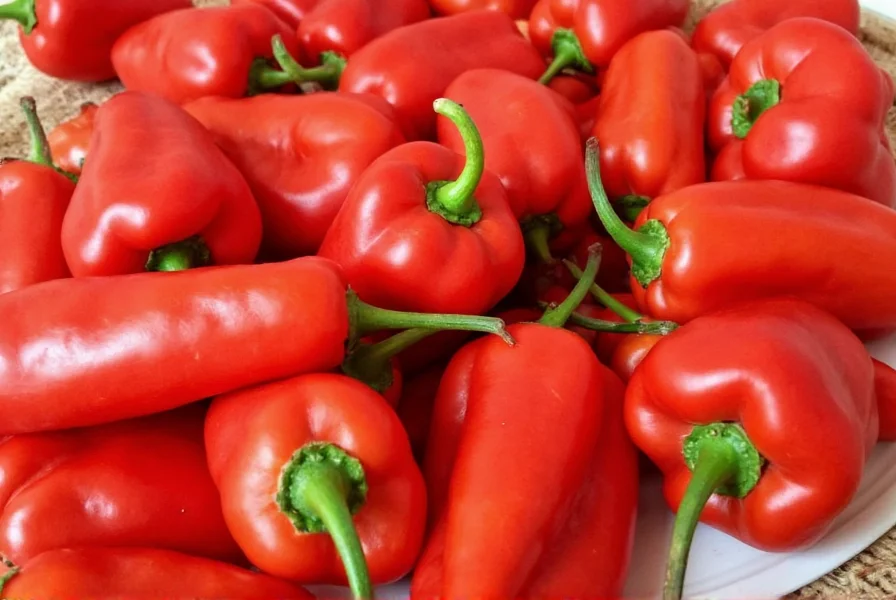| Pepper Type | Heat Level (Scoville Units) | Flavor Notes | Best For |
|---|---|---|---|
| Cayenne Pepper | 30,000–50,000 | Sharp, Fruity, Smoky | Sauces, Spices, Dishes needing consistent heat |
| Jalapeño | 2,500–8,000 | Grassy, Bright | Tacos, Nachos, Popcorn Chicken |
| Habanero | 100,000–350,000 | Fruity, Tropical | Hot Sauces, Caribbean Dishes |
What Are Cayenne Peppers?
Cayenne peppers are a staple in global cuisines, known for their vibrant red color and consistent heat. Originating from South America, these slender, pointed peppers deliver a sharp, fruity flavor with moderate heat (30,000–50,000 Scoville units), making them ideal for adding reliable spice without overwhelming other flavors.
Unlike round peppers like cherry peppers, cayenne peppers are long and thin, typically measuring 2–5 inches. They're dried and ground into the familiar red powder used in everything from hot sauces to spice blends.
Taste & Heat: What Makes Cayenne Special?
Cayenne peppers offer a clean, straightforward heat that builds gradually. Their flavor profile includes subtle fruity notes and a smoky undertone when roasted. Unlike habaneros with intense tropical fruitiness or jalapeños with grassy freshness, cayenne provides consistent heat perfect for balancing dishes.
Top 5 Ways to Use Cayenne Peppers in Cooking
- Homemade Hot Sauce: Blend fresh cayenne peppers with vinegar, garlic, and a touch of honey for a versatile sauce that enhances everything from eggs to grilled meats.
- Spice Rubs: Mix ground cayenne with paprika, cumin, and brown sugar for a smoky-sweet rub perfect for ribs or chicken.
- Infused Oils: Steep dried cayenne in olive oil for 48 hours to create a flavorful oil for drizzling over pizza or pasta.
- Spicy Soups & Stews: Add a pinch of cayenne powder to tomato-based soups or chili to deepen flavor without adding bulk.
- Seasoning for Snacks: Toss popcorn or roasted nuts with melted butter, cayenne, and sea salt for a quick, addictive snack.
Buying Guide: Choosing the Best Cayenne Peppers
When selecting cayenne peppers, look for:
- Fresh Peppers: Firm, smooth skin with deep red color (avoid wrinkled or soft spots). They should have a sharp, peppery aroma.
- Dried Cayenne Powder: Choose vibrant red powder with no clumping. Store in airtight containers away from light to preserve potency.
Top Pick: Organic Cayenne Pepper Powder

- Features: Sun-dried, non-GMO, and free from additives.
- Advantages: Consistent heat level, rich color, and no bitter aftertaste.
- Use Cases: Ideal for spice blends, hot sauces, and seasoning savory dishes.
- Target Audience: Home cooks and professional chefs seeking reliable heat.
Health Benefits of Cayenne Peppers
- Rich in Vitamin C: Boosts immunity and supports skin health.
- Metabolism Support: Capsaicin may temporarily increase calorie burning.
- Anti-Inflammatory: Studies show capsaicin reduces inflammation markers.
- Heart Health: May help lower LDL cholesterol and blood pressure.
Frequently Asked Questions About Cayenne Peppers
How hot are cayenne peppers compared to other common peppers?
Cayenne peppers range from 30,000 to 50,000 Scoville Heat Units, making them significantly hotter than jalapeños (2,500-8,000 SHU) but milder than habaneros (100,000-350,000 SHU). They provide consistent heat without overpowering flavors.
What's the best way to handle cayenne peppers safely?
Wear gloves when handling fresh cayenne peppers to avoid skin irritation. Avoid touching your face, especially eyes. Work in a well-ventilated area, and wash hands thoroughly with soap after handling. Clean all surfaces that contact the peppers.
Can I substitute cayenne peppers if I can't find them?
Yes. For fresh cayenne, use serrano peppers (slightly hotter) or jalapeños with added cayenne powder. For dried cayenne powder, substitute with crushed red pepper flakes or paprika with a pinch of cayenne for similar heat.
How should I store fresh cayenne peppers?
Store fresh cayenne peppers in the refrigerator's vegetable crisper drawer inside a paper bag. They'll stay fresh for 1-2 weeks. For longer storage, freeze whole peppers or dry them at home.
Are cayenne peppers the same as red pepper flakes?
No. Red pepper flakes are typically made from multiple pepper varieties (including cayenne), but they often include seeds and stems, which can create uneven heat. Pure cayenne powder is ground from only the pepper flesh for consistent flavor and heat.
What's the best way to reduce heat in a dish with cayenne?
Remove seeds and membranes before using fresh cayenne. Balance heat with dairy (yogurt, sour cream), acid (lime juice), or sweetness (honey). Adding more of the dish's base ingredients will also dilute spiciness.
Final Thoughts
Cayenne peppers are a kitchen essential for adding reliable heat and depth to any dish. Their versatility—from fresh peppers to powdered form—makes them indispensable for home cooks and chefs alike. Whether you're spicing up a simple meal or crafting gourmet hot sauce, cayenne delivers consistent flavor that elevates your cooking.










 浙公网安备
33010002000092号
浙公网安备
33010002000092号 浙B2-20120091-4
浙B2-20120091-4